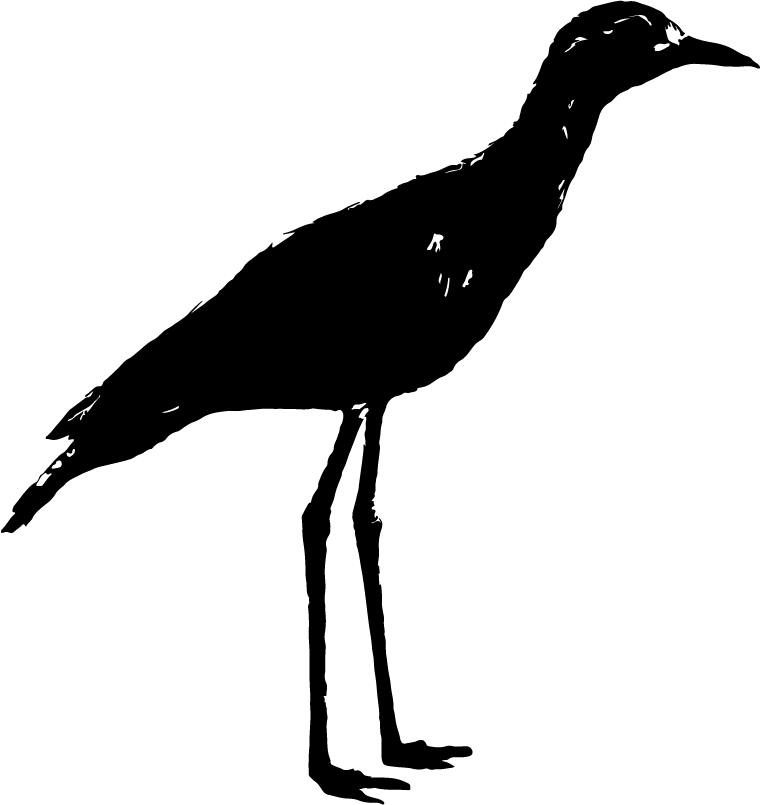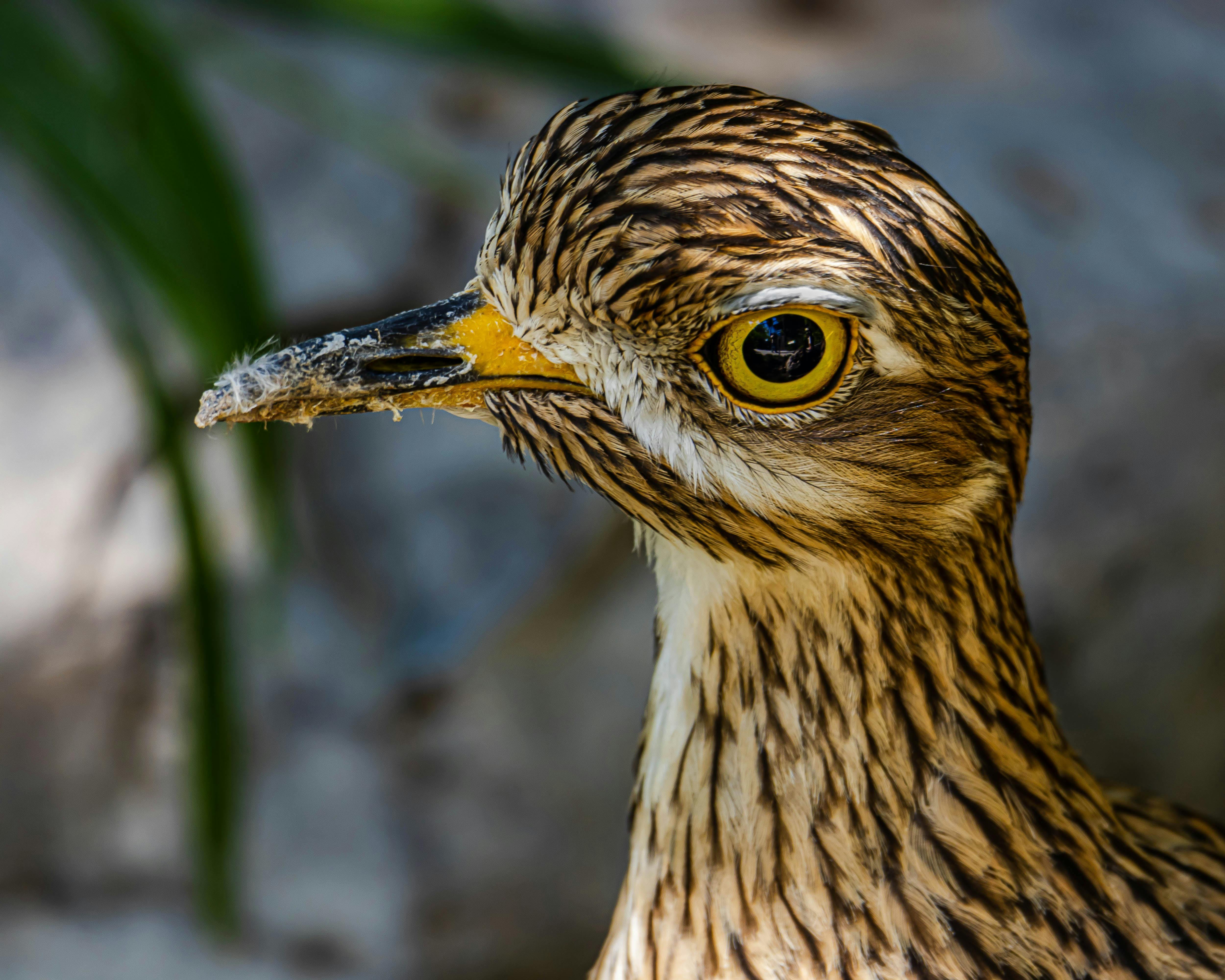Did you ever get the feeling someone or something was watching you? As the sun lowers in the sky, an orange-purple haze fills a void of dusky, still air that signals something to creatures of the night, it's time to wonder out. Before all the crowds have disappeared, you chance a glance behind to check the identity of your onlooker. There, standing 60 cm tall is the transfixed stare from a golden yellow orb of an eye, that pierces your soul in a way I can only compare to Tolken’s Eye of Sauron. Only, this eye rests atop an elegant skeleton of a knobbly kneed, curious looking bird, named the Stone-Curlew; unblinking and motionless as a statue whilst it calculates your movements. With a thick beak, protruding long enough to put you at unease as you wonder what goes on in the mind of a bird with an eye that appears larger than its brain?
Stone Curlews are a most unusual and memorable bird. This description is not based solely on appearances, since their camouflaged, brown-white-blackish feathers cannot compete against the exotic, iridescent rainbows and magnificent plumages of birds from the tropics. No, Stone-Curlews’ speciality touches upon your sixth sense, in the unique way they make you feel. Each stealth-like movement, accompanied by their reptilian mechanical eye and eerie ghost-like presence, interrupted only by a bellowing sombre call, sends shivers; whether you call it creepy or beautifully mystic, each encounter undoubtedly leaves a lasting impression.
Stone-Curlews are a type of shorebird from the family Burhinidae, related to Oystercatchers and Hooded plovers. However, they can easily be confused with True Curlews (family Scolopacidae) that are more distantly related than you’d expect given their similar appearances and equally memorable calls. Eight different species of Stone-Curlew can be found living from Europe, Africa, South Asia and Australia. They may also commonly be referred to by another of their distinctive features - Thick-Knees - having a particularly thick or knobbly joint protruding from their long, spindly chicken legs, that uncomfortably bend backwards. Though notably, these are not their knees but instead equivalent to our ankles, with the actual “knee” joint hidden from sight.
Typically, these ground-dwelling birds prefer bare, semi-arid, stony open ground with patches of short grass. They are nocturnal night hunters so avoid dense vegetation, even with their gawking wide yellow eye, foraging for insects is made easier in the open ground. In temperate regions, they’re found stalking sandy heaths, well-grazed grassland or arable fields. Whilst their tropical hideouts also include mangroves, mudflats, salt marshes and rainforest fringes. Remarkably, they still keep themselves well hidden within these wide open spaces, disguised by their cryptic plumage and a fossilised-like stillness.
In Australia, these peculiar yellow-eyed birds unusually live closely together amongst city dwellers in the Queensland state capital of Brisbane. Known as the Bush Stone-Curlew (Burhinus grallarius), they are the city’s nighttime neighbourhood watch; patrolling the local streets, urban green spaces and even shopping malls. The region is home to a stable population of roughly 150 breeding pairs with adult survival rates of 94.47% documented on a closely neighbouring island to the city. But this is not the norm. Elsewhere across southern parts of Australia and around the world, these distinctive birds are in decline from human-based impacts including, predation by cats and foxes, habitat loss, egg trampling and agricultural chemicals including pesticides and fertilisers.
However, within Brisbane’s moderate concrete jungle and sprawling, suburban city life, Stone-Curlews have settled in surprisingly well. In this early-to-bed city, they appear to enforce an after-dark, anthropic curfew. They can be found lurking down your street, in public parks, playgrounds or empty car parks, safeguarding havens of insects attracted by the bright city lights. At the end of my weekly football practices players were ushered off the field by a workforce of Stone-Curlew groundsmen, policing the pitch’s closure at sunset. Hungry for dinner, the short-cut playing field grass made a suitable patch to find delicacies of beetles, snails or even the odd lizard!
If not from the heavy weight of their stare, Stone-Curlews impress upon your conscious with their wailing, soul-searching song. Stone-Curlews live up to 30 years and mate with their partners for life, whom it seems they regularly lose and must call for at the beginning of each night. In Brisbane’s leafy suburbs, the sounds of this elongated, chilling call are a nightly echo. Each high-pitched call temporarily dominates the nighttime soundscape and is subsequently followed by a deathly, waiting silence; they leave just enough time to ease your senses before the corresponding hallow greets you with an equally shuddering surprise. The exchange of calls between two individuals gets nearer and nearer until the two birds are close enough to reunite by sight. This they do, somewhat like a long jumper’s run-up, in a brisk but gangly fashion.
The lifelong fidelity of Stone-Curlews makes their courtship rituals a rare sighting. However, for this otherwise shy bird of the shadows, they nonetheless mark the occasion with an extroverted demonstration of male prowess. The exuberant dance involves stamping feet whilst stretching out its impressive 80cm wing span, positioning the tail upright and tilting its neck ever so slightly forward as a ballet dancer’s arabesque. Simultaneously, the male birds sing out to females and perform like this for up to an hour until they receive that longed-for flutter of her eyelids. Stone-Curlews lay between 1 and 2 eggs per roost, that they nestle amongst fallen leaves, twigs and sparse grass on the ground. The Eurasion Stone-Curlew (Burhinus oedicnemus) is the only species to travel for this affair, migrating from Northern Africa to Europe each year, from late March through to October. Whilst southern hemisphere Australian residents lay eggs from July through January. Curlew chicks are self-sufficient from day one but stay around for 9 months with their parents, learning the ways of the Curlew night watch.
That the Stone-Curlew has successfully adapted to live within these Australian urban regions is some ecological magic! Whilst they might be seen as ominous night watchers by some, we are truly lucky if we live amongst such graceful birds. I’d much rather be looked upon by their yellow-eyed stare, than me look upon their beauty lost amongst our man-torn earth.







